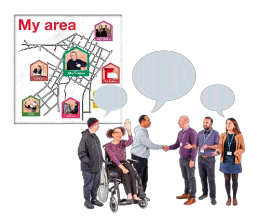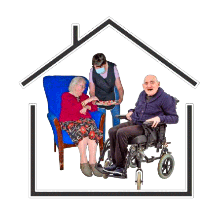National Care Service evidence paper: national systems of social care in Nordic countries - easy read
This easy read summary provides an overview of research evidence and learning from Nordic and Scandinavian national systems of social care.
Social care services in Nordic countries
What did we do?

We looked at health and social care systems from Nordic countries from 2010 to 2022.
Nordic countries are Norway, Sweden, Finland and Denmark.
What we found

There was not one way of delivering social care services in the countries we looked at.
Each country was different, depending on how services were led and funded.
At different times there were different politics and benefits systems.
This meant that services were often controlled and delivered differently.
User experience

The studies found that relationships between users of care services, staff and unpaid carers were very important.

This helped to make sure:
- people got the services they needed, where they wanted them
- they were being listened to about what they wanted
- different parts of the system worked well together

Some people did not have equal access to good services, particularly people with complex needs.
Governance

Governance is the rules about how an organisation works.

These things should be part of governance systems:

- a clear aim for all parts of care to work well together
- laws that are supportive and clear

- only make very important parts into law – leave other parts to be flexible for different areas and different needs
- be clear about roles and responsibilities and levels of funding
- look at:
- how people experience social care
- how and where it is delivered
- and how it meets what people need
Funding

Funding should look at:
- all stakeholders agreeing the same aims
- making sure organisations and processes work together
- making sure needs are met in local areas

Funding was often difficult because of:

- different ways of paying for things
- separate budgets
- the ways money moves between different parts of the system

Marketisation in health and social care means a system driven by competition and profit.

Marketisation:
- gives care users more choice
- makes healthcare fairer because people do not have to rely on one organisation
- could improve quality of care because of competition between providers
- means that care systems work together
- tends to benefit people who can afford to pay for better services or more services
Involving people who use health and social care services

Health and social care staff say that working together with people who use services is the best way to make sure services are delivered well.
This can take a lot of time especially when developing individual care plans.

It is important to have good safeguarding systems across all levels of staff and service providers to make sure people are safe from harm and treated in the right way across the care system.

Cooperation and trust between different parts of the system and service providers was important.
This included the sharing of resources and responsibilities to deliver quality services.
This went beyond just health and social care integration and could include other sectors such as education and employment.

Shared information and communication systems were seen as good ways to help integration work.
They also made service quality and workforce development better.

Where people can safely get care is an important part of meeting their needs.
Care at home services must be planned for as well as care in places like care homes.
Workforce

Staff should have:
- chances to go to training and courses
- good work conditions
- a chance for staff across the social care workforce to work and deliver services at a local level to meet the needs of local people
Population health outcomes

Studies show:
- that access to care is not equal.
There are needs not being met across European countries, especially for people on the lowest incomes or people who live in poorer areas

- costs that were more likely to affect the poorest and most vulnerable older people

It is difficult to say if integrated health and social care meant that there was lower demand for services elsewhere in health care.
What this report does not tell us

- it does not tell us what works, or give a detailed look at national social care systems from Nordic countries
- it does not include children's services
- it does not look at community and local programmes of social care services
- or about voluntary organisations involved in delivery of care services
What does this mean for policy and research?

There was not one single national way of providing social care services.
There was no agreement on the best way to lead or fund arrangements.

The evidence does show standards and ways of working that help or do not help to make a national social care service.

There was not much evidence that national social care systems in Nordic countries had been checked to see if they were working well.
Contact
Email: SWstat@gov.scot
There is a problem
Thanks for your feedback